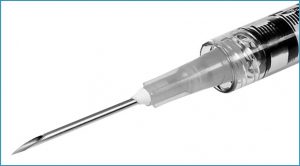 While many people may be lucky enough to have never undergone hospital treatment, one medical device most people are familiar with is hypodermic needles. These devices are used by doctors to inject and withdraw fluids in or out of the body, hence the name – a Latin translation of “under the skin.” In fact, the World Health Organization estimates that 16 million injections are administered worldwide, every single year.
While many people may be lucky enough to have never undergone hospital treatment, one medical device most people are familiar with is hypodermic needles. These devices are used by doctors to inject and withdraw fluids in or out of the body, hence the name – a Latin translation of “under the skin.” In fact, the World Health Organization estimates that 16 million injections are administered worldwide, every single year.
Hypotube Device Applications
Besides the barrel, plunger, needle, and cap, one of the most important components of the hypodermic needle is the hypotube – a hollow tube of small diameter, typically made from stainless steel. While hypotubes get their name from hypodermic needles, they are important components of many other medical devices, including cannulas and catheters.
Catheters are a well-known way of infusing medicine into a patient’s bloodstream. They are often also deployed in complex, minimally invasive surgeries such as the removal of blood clots, insertion of implants, or the targeted administration of drugs. In these applications, the hypotube’s role is very important.
“Hypotubes can be used as a pathway for another device using the structure of the tube for protection during deployment,” explains Jim Boldig, director of sales and engineering at Custom Wire Technologies (CWT), providers of custom precision wire components for medical devices. “Another application is to allow a component to be placed down the inside of the hypotube. Such components could be a fiber optic cable used to connect to a pressure sensor on a guidewire. These hypotubes provide a rigid over-structure to protect key components,” explains Boldig.
To make the component suitable for these critical and innovative applications, hypotubes need to be small and flexible, enabling them to steer catheters through arteries that typically have an internal diameter of 4mm. At the same time, they need to be robust enough to avoid kinking and pushing during surgical procedures.
Custom Hypotubes
When sourcing hypotubes, OEMs can find many standard products available on the market. Most manufacturers have charts defining the outside diameter, inside diameter, and wall thickness of their varied hypotube sizes. Sometimes, hypotubes need to be customized with sharp tips, tapers, or steps. This can be achieved by grinding the metal, often a difficult process due to the tight tolerances required. Custom Wire Technologies is an industry expert when it comes to grinding medical wire and hypotube components. “Customizing these tubes at the mill can be difficult,” says Boldig. “CWT can grind the outside diameter to custom OD/ID combinations. This is extremely helpful when custom tube draws can take months to complete. Our OD grinding capability allows for the creation of windows or sharp features.”
“We can be very competitive when prototyping for custom needles is desired. We can also offer low-volume production quantities and pricing for customers who require more than prototyping,” he adds.
CWT Hypotube Capabilities
The other capability that sets CWT apart in this space is their ability to hold those tight tolerances necessitated by the hypotube. CWT frequently holds diameter tolerances as tight as 0.0002” and wall thicknesses as small as 0.001”.
“Our equipment is the reason we can hold such tight tolerances,” says Boldig. “They are some of the most sophisticated grinding machines in the world. It also requires attention to detail when these machines are being setup. Our experience and reputation for providing high-quality products gives customers the confidence that we can exceed their expectations.”
CWT has been working with tubing suppliers since the company’s inception, also earning it a reputation amongst its suppliers as a reputable customer. “Our vendors know that we aren’t ‘shopping’ for the cheapest option,” explains Boldig. “Our goal is to source the highest quality materials from the best suppliers in the world. When we come to them with an RFQ it usually means an order is coming. Our suppliers appreciate the efficiency and simplicity of our relationship.”
Hypotube Trends
With the constant demand for hypodermic needles combined with their increased deployment in minimally invasive surgeries, hypotubes will remain a critical component in the medical device supply chain. When it comes to industry trends, CWT believes nitinol hypotubes are gaining popularity, although these are extremely expensive in comparison to their stainless-steel counterparts. According to Boldig, laser cut hypotubes, used to cut spiral patterns for greater flexibility, is another trend to look out for. This is similar in function to the traditional design of a guidewire, composed of coil and corewire.



